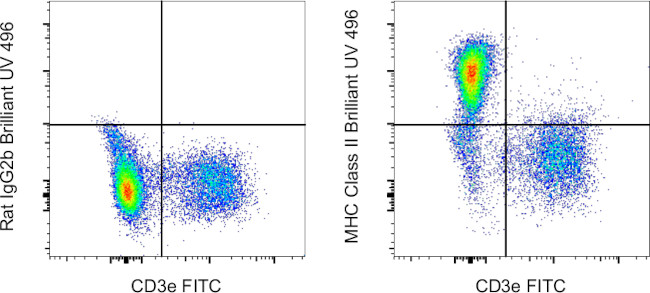Search Thermo Fisher Scientific
Invitrogen
MHC Class II (I-A/I-E) Monoclonal Antibody (M5/114.15.2), Brilliant Ultra Violet™ 496, eBioscience™
FIGURE: 1 / 1
MHC Class II (I-A/I-E) Antibody (364-5321-82) in Flow

Product Details
364-5321-82
Species Reactivity
Host/Isotype
Recommended Isotype Control
Class
Type
Clone
Conjugate
Excitation/Emission Max
Form
Concentration
Purification
Storage buffer
Contains
Storage conditions
Shipping conditions
RRID
Product Specific Information
Description: The M5/114.15.2 monoclonal antibody reacts with the mouse major histocompatibility complex class II, both I-A and I-E subregion-encoded glycoproteins (I-A b, I-A d, I-A q, I-E d, I-E k, not I-A f, I-A k, or I-A s). It detects a polymorphic determinant present on B cells, monocytes, macrophages, dendritic cells, and activated T lymphocytes from mice carrying the H-2 b, H-2 d, H-2 q, H-2 p, H-2 r and H-2 u but not from mice carrying the H-2 s or H-2 f haplotypes. The M5/114 mAb is reported to inhibit I-A-restricted T cell responses of the H-2 b, H-2 d, H-2 q, H-2 u but not H-2 f, H-2 k, or H-2 s haplotypes.
Applications Reported: This M5/114.15.2 antibody has been reported for use in flow cytometric analysis.
Applications Tested: This M5/114.15.2 antibody has been tested by flow cytometric analysis of mouse splenocytes. This may be used at less than or equal to 0.25 µg per test. A test is defined as the amount (µg) of antibody that will stain a cell sample in a final volume of 100 µL. Cell number should be determined empirically but can range from 10^5 to 10^8 cells/test. It is recommended that the antibody be carefully titrated for optimal performance in the assay of interest.
Brilliant Ultra Violet™ 496 (BUV496) is a tandem dye that emits at 496 nm and is intended for use on cytometers equipped with an ultraviolet (355 nm) laser. Please make sure that your instrument is capable of detecting this fluorochrome.
When using two or more Super Bright, Brilliant Violet™, Brilliant Ultra Violet™, or other polymer dye-conjugated antibodies in a staining panel, it is recommended to use Super Bright Complete Staining Buffer (Product # SB-4401-42) or Brilliant Stain Buffer™ (Product # 00-4409-75) to minimize any non-specific polymer interactions. Please refer to the datasheet for Super Bright Staining Buffer or Brilliant Stain Buffer for more information.
Light sensitivity: This tandem dye is sensitive to photo-induced oxidation. Please protect this vial and stained samples from light.
Fixation: Samples can be stored in IC Fixation Buffer (Product # 00-8222-49) (100 µL of cell sample + 100 µL of IC Fixation Buffer) or 1-step Fix/Lyse Solution (Product # 00-5333-54) for up to 3 days in the dark at 4°C with minimal impact on brightness and FRET efficiency/compensation. Some generalizations regarding fluorophore performance after fixation can be made, but clone-specific performance should be determined empirically.
Excitation: 350 nm; Emission: 496 nm; Laser: Ultraviolet Laser.
BRILLIANT ULTRA VIOLET™ is a trademark or registered trademark of Becton, Dickinson and Company or its affiliates, and is used under license. Powered by Sirigen™.
Target Information
MHC (major histocompatibility complex) class II molecules are transmembrane glycoproteins expressed on the surface of professional antigen-presenting cells, such as macrophages, dendritic cells and B cells. Before their exposition on the cell surface, the MHC class II molecules react with endocytosed exogenous antigens, which are then presented to the T cells. The antigen-binding grove between MHC class II alpha and beta chain is open at both ends and is 15-24 amino acid residues long.
HLA and MHC antibodies play a significant role in Immunopeptidomics, facilitating the identification and characterization of neoantigens through high-performance liquid chromatography coupled to tandem Mass Spectrometry.
For Research Use Only. Not for use in diagnostic procedures. Not for resale without express authorization.
How to use the Panel Builder
Watch the video to learn how to use the Invitrogen Flow Cytometry Panel Builder to build your next flow cytometry panel in 5 easy steps.
References (0)
Bioinformatics
Protein Aliases: A alpha; cell surface glycoprotein; H-2 class II histocompatibility antigen, A beta chain; H-2 class II histocompatibility antigen, A-B alpha chain; H-2 class II histocompatibility antigen, A-F alpha chain; H-2 class II histocompatibility antigen, A-K alpha chain; H-2 class II histocompatibility antigen, A-Q alpha chain; H-2 class II histocompatibility antigen, A-R alpha chain; H-2 class II histocompatibility antigen, A-S alpha chain; H-2 class II histocompatibility antigen, A-U alpha chain; H-2 class II histocompatibility antigen, I-E beta chain; histocompatibility 2, class II antigen A, alpha; histocompatibility 2, class II antigen A, beta 1; I-Ab; I-Ad; I-Aq; I-E beta MHC class II; I-Ed; I-Ek; IAalpha; major histocompatibility complex class II beta chain; major histocompatibility complex H-2E beta chain; major histocompatibility protein class II alpha chain; MHC class 2; MHC class II antigen A alpha isoform-004; MHC class II antigen A beta; MHC class II H2-IA-beta-psi; MHC class II IE-b; MHC H2-IE-beta cell surface glycoprotein; MHC-II I-A(d) alpha; response to metastatic cancers 1
Gene Aliases: Aalpha; Abeta; AI845868; H-2Aa; H-2Ab; H-2Eb; H2-Aa; H2-Ab; H2-Ab1; H2-iabeta; H2Aa; H2Eb; I-Aalpha; I-Abeta; Ia-1; Ia-2; Ia-4; Ia1; Ia2; Ia4; IAalpha; IAb; Rmcs1
UniProt ID: (Mouse) P14434, (Mouse) P14483
Entrez Gene ID: (Mouse) 14960, (Mouse) 14961, (Mouse) 14969

Performance Guarantee
If an Invitrogen™ antibody doesn't perform as described on our website or datasheet,we'll replace the product at no cost to you, or provide you with a credit for a future purchase.*
Learn more
We're here to help
Get expert recommendations for common problems or connect directly with an on staff expert for technical assistance related to applications, equipment and general product use.
Contact tech support

